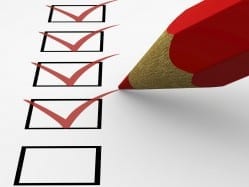A couple weeks ago, I introduced you to the Positive Force Consulting Event Planning 101 series with the promise of offering strategies and tips for your next event planning endeavor. And now it’s time to get started!

The most important stage of planning any event occurs at the beginning. Your very first step is to set your goals for the event. In other words, why do you want to organize the event in the first place? Is it a fundraiser? Or an event to raise awareness and education about your cause? Or is it merely a way to bring people together to have a good time? Your answer may be a simple sentence or it may incorporate several different reasons. It doesn’t matter how many (or how few) you have; just be sure that the goals are realistic, concrete, and that you identify how you will measure their success.
If one of your goals is to raise a certain amount of money, then “sell X number of tickets” could be one method of measuring your success of achieving this goal. Or, if you’re hoping to increase the number of members in your new book club with a special event, “an increase in Facebook “likes”’ might be one way to measure the success of your event, assuming you ask attendees to “like” your book club Facebook page.
Once you’ve set your event goals, I recommend you then create a list of pre-event, day of event, and post-event tasks and deadlines. The list of goals you’ve just made should assist you in determining the things you will need to get done and the deadlines associated with each, even if they are approximate. These deadlines will become your “mini goals” and will help you achieve the big picture goal(s). Here are a few examples:
- Pre-event tasks include securing a location/venue, hiring outside vendors, sending invitations, and promoting the event on social media.
- Day of event tasks include paying vendors, checking that all visual and audio equipment works, and ensuring your speakers and/or special guests have arrived and have everything they need.
- Post-event tasks include sending thank you/follow-up cards to attendees and assessing whether your goals were met.
After you have completed your tasks list, notify anyone who will be assisting you in event planning process so that they are keyed in to the event details and their individual roles and responsibilities.
Finally, create a SWOT Analysis. You remember those, don’t you? Everyone loves a good SWOT!

- Strengths: Do you and/or your team bring vast or varied experience to the table? Are you and/or your team highly motivated? Do you have adequate resources to fund your event? Do you have a strong network or media contacts to help promote your event?
- Weaknesses: Are you and/or your team lacking experience or motivation? Is your network small or not likely to help spread the word? Are funds low? Be honest with yourself when you answer these. With a little creativity and hard work you can overcome anything.
- Opportunities: Is there little competition with other events going on at the same time? Is your event truly unique? Do you have strong support in the community? Does someone owe you a favor? (This can be a great time to call one in!)
- Threats: Are you throwing an event during a busy time (i.e. holidays) or during a time when it’s tough for people to attend due to weather or unfavorable economic conditions?
The SWOT Analysis will help you to identify the challenges (aka “Weaknesses” and “Threats”) you might face during the planning process but it also highlights the aspects of the planning process you shouldn’t worry too much about (aka “Strengths” and “Weaknesses”).
You are now ready to move onto the next step (and the next post in this series): Budgeting!
Don’t forget, this series is meant to assist you. I encourage you to ask your event planning questions in the Comments section below or via Facebook or Twitter. I will do my very best to address each and every one of them!








Responses